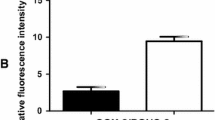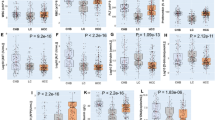Abstract
Chronic hepatitis C virus (HCV) infection is associated with increased levels of peripheral T cell apoptosis. We aimed to study whether T cell apoptosis markers indicate pathways that may contribute to clinical progression in HCV monoinfected and HIV–HCV coinfected patients. Activation of the extrinsic apoptosis pathways was measured by levels of death receptor Fas, initiator caspase 8 and effector caspases 3 and 7 activity and Annexin V binding on peripheral CD4 and CD8 T cells of HCV monoinfected and HIV/HCV coinfected patients, as well as healthy controls and HIV-infected, hepatitis B virus-infected and primary biliary cirrhosis disease controls. Association with liver fibrosis was assessed by biopsy or by transient elastography. HCV monoinfected and HIV–HCV coinfected patients displayed enhanced peripheral CD4 and CD8 T cell apoptosis. Caspase 8 activity was highest in HIV–HCV coinfection, without enhanced downstream activity of caspases 3 and 7. Level of peripheral T cell apoptosis was independent of liver fibrosis or other disease parameters in all disease groups. The extrinsic apoptosis pathway is upregulated in HCV monoinfection and HIV–HCV coinfection, but this is independent of liver disease severity.




Similar content being viewed by others
References
Sherman KE et al (1993) Quantitative evaluation of hepatitis C virus RNA in patients with concurrent human immunodeficiency virus infections. J Clin Microbiol 31:2679–2682
Bonacini M, Govindarajan S, Blatt LM, Schmid P, Conrad A, Lindsay KL (1999) Patients co-infected with human immunodeficiency virus and hepatitis C virus demonstrate higher levels of hepatic HCV RNA. J Viral Hepat 6:203–208
Koziel MJ, Peters MG (2007) Viral hepatitis in HIV infection. N Engl J Med 356:1445–1454
Arends JE et al (2011) Low doses of the novel caspase-inhibitor GS-9450 leads to lower caspase-3 and -8 expression on peripheral CD4+ and CD8+ T-cells. Apoptosis 16:959–966
Albertoni G et al (2012) Altered of apoptotic markers of both extrinsic and intrinsic pathways induced by hepatitis C virus infection in peripheral blood mononuclear cells. Virol J 9:314
Cummins NW, Badley AD (2010) Mechanisms of HIV-associated lymphocyte apoptosis: 2010. Cell Death Dis 1:e99
Nagata S (1999) Fas ligand-induced apoptosis. Annu Rev Genet 33:29–55
Ju ST et al (1995) Fas(CD95)/FasL interactions required for programmed cell death after T-cell activation. Nature 373:444–448
Kischkel FC et al (1995) Cytotoxicity-dependent APO-1 (Fas/CD95)-associated proteins form a death-inducing signaling complex (DISC) with the receptor. EMBO J 14:5579–5588
Chinnaiyan AM, O’Rourke K, Tewari M, Dixit VM (1995) FADD, a novel death domain-containing protein, interacts with the death domain of Fas and initiates apoptosis. Cell 81:505–512
Peter ME, Krammer PH (2003) The CD95(APO-1/Fas) DISC and beyond. Cell Death Differ 10:26–35
Rosen HR (2011) Clinical practice. Chronic hepatitis C infection. N Engl J Med 364:2429–2438
Hernandez-Gea V, Friedman SL (2011) Pathogenesis of liver fibrosis. Annu Rev Pathol 6:425–456
Claassen MA, Janssen HL, Boonstra A (2013) Role of T cell immunity in hepatitis C virus infections. Curr Opin Virol 3(4):461–467
Protzer U, Maini MK, Knolle PA (2012) Living in the liver: hepatic infections. Nat Rev Immunol 12:201–213
Rehermann B (2013) Pathogenesis of chronic viral hepatitis: differential roles of T cells and NK cells. Nat Med 19:859–868
Crispe IN, Dao T, Klugewitz K, Mehal WZ, Metz DP (2000) The liver as a site of T-cell apoptosis: graveyard, or killing field? Immunol Rev 174:47–62
Iken K, Huang L, Bekele H, Schmidt EV, Koziel MJ (2006) Apoptosis of activated CD4+ and CD8+ T cells is enhanced by co-culture with hepatocytes expressing hepatitis C virus (HCV) structural proteins through FasL induction. Virology 346:363–372
Muhanna N et al (2008) Activation of hepatic stellate cells after phagocytosis of lymphocytes: a novel pathway of fibrogenesis. Hepatology 48:963–977
Bataller R, Brenner DA (2005) Liver fibrosis. J Clin Investig 115:209–218
Canbay A, Friedman S, Gores GJ (2004) Apoptosis: the nexus of liver injury and fibrosis. Hepatology 39:273–278
Kobayashi S et al (2003) Apoptosis of T cells in the hepatic fibrotic tissue of the rat: a possible inducing role of hepatic myofibroblast-like cells. Cell Tissue Res 311:353–364
Wong DK et al (1998) Liver-derived CTL in hepatitis C virus infection: breadth and specificity of responses in a cohort of persons with chronic infection. J Immunol 160:1479–1488
Neumann-Haefelin C et al (2008) Virological and immunological determinants of intrahepatic virus-specific CD8+ T-cell failure in chronic hepatitis C virus infection. Hepatology 47:1824–1836
Feuth T et al (2013) Complementary role of HCV and HIV in T-Cell activation and exhaustion in HIV/HCV coinfection. PLoS One 8:e59302
Hahn CS, Cho YG, Kang BS, Lester IM, Hahn YS (2000) The HCV core protein acts as a positive regulator of Fas-mediated apoptosis in a human lymphoblastoid T cell line. Virology 276:127–137
Otsuka M et al (2002) Hepatitis C virus core protein inhibits apoptosis via enhanced Bcl-xL expression. Virology 296:84–93
Sacco R et al (2003) Antiapoptotic regulation by hepatitis C virus core protein through up-regulation of inhibitor of caspase-activated DNase. Virology 317:24–35
Budd RC (2001) Activation-induced cell death. Curr Opin Immunol 13:356–362
Green DR, Droin N, Pinkoski M (2003) Activation-induced cell death in T cells. Immunol Rev 193:70–81
Brenner D, Krammer PH, Arnold R (2008) Concepts of activated T cell death. Crit Rev Oncol Hematol 66:52–64
Kita H et al (2002) Quantitative and functional analysis of PDC-E2-specific autoreactive cytotoxic T lymphocytes in primary biliary cirrhosis. J Clin Investig 109:1231–1240
Nakamura M et al (2012) Genome-wide association study identifies TNFSF15 and POU2AF1 as susceptibility loci for primary biliary cirrhosis in the Japanese population. Am J Hum Genet 91:721–728
Tsuda M et al (2011) Fine phenotypic and functional characterization of effector cluster of differentiation 8 positive T cells in human patients with primary biliary cirrhosis. Hepatology 54:1293–1302
Huang L, Soldevila G, Leeker M, Flavell R, Crispe IN (1994) The liver eliminates T cells undergoing antigen-triggered apoptosis in vivo. Immunity 1:741–749
Schmidt-Mende J, Hellstrom-Lindberg E, Joseph B, Zhivotovsky B (2000) Freezing induces artificial cleavage of apoptosis-related proteins in human bone marrow cells. J Immunol Methods 245:91–94
Deeks SG (2009) Immune dysfunction, inflammation, and accelerated aging in patients on antiretroviral therapy. Top HIV Med 17:118–123
Lamkanfi M, Festjens N, Declercq W, Vanden Berghe T, Vandenabeele P (2007) Caspases in cell survival, proliferation and differentiation. Cell Death Differ 14:44–55
Maelfait J, Beyaert R (2008) Non-apoptotic functions of caspase-8. Biochem Pharmacol 76:1365–1373
Conflict of interest
The authors declare that they have no conflict of interest.
Author information
Authors and Affiliations
Corresponding author
Rights and permissions
About this article
Cite this article
Feuth, T., Van Baarle, D., Hoepelman, A.I.M. et al. Activation of extrinsic apoptosis pathway in HCV monoinfected and HIV–HCV coinfected patients, irrespective of liver disease severity. Apoptosis 19, 1128–1135 (2014). https://doi.org/10.1007/s10495-014-0992-1
Published:
Issue Date:
DOI: https://doi.org/10.1007/s10495-014-0992-1




